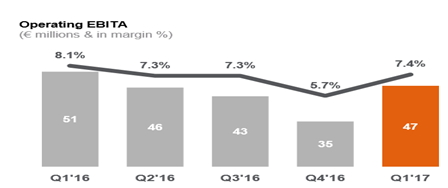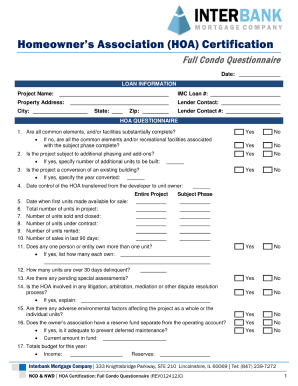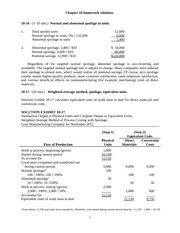

https://1investing.in/ accounting, therefore, ensures that a business does not overspend its budget. In accounting, an encumbrance is an open commitment to pay for goods or services ahead of the actual purchase. In other words, the purchasing company makes a promise to pay before the expense is incurred. Once the transaction is approved, the commitment becomes legally binding. Encumbrances are also known as pre-expenditures since they act as budgeted reserve funds before the actual expenditure. Budgetary Control refers to a group of system options and the processes that’s used to determine which transactions are subjected to validation against budgets and budget consumption to prevent overspending.
Encumbrance accounting has many benefits for a company, including better visibility, improved expenditure control, and more precise analysis. This type of accounting also helps detect fraud, prevent rampant spending, and increases budget control. When you decide to carry cover encumbrances, check that all journal entries are correctly made and that all the balances you’re bringing forward are correct, since the balances you bring forward cannot be reversed. Contract and Grant Cost Share Encumbrances are created for purchase orders that are cost-share funded and coded with balance type code CE. Pre-encumbrances, created and relieved using the Pre-encumbrance e-doc, allow departments to further commit funds to facilitate financial management.
- Encumbrance accounting is also referred to as commitment accounting, which involves setting aside money ahead of time to meet anticipated expenses.
- This intent implies that the business is highly likely to spend money in the future, which implies a commitment to make a purchase.
- We streamline legal and regulatory research, analysis, and workflows to drive value to organizations, ensuring more transparent, just and safe societies.
- Other examples of encumbrance can include money set aside for payroll, allotted cash for monthly fees such as utilities or rent, and cash that is set aside for taxes or other longer-term fees.
Paying the expense after the money has been encumbered doesn’t affect the amount of the appropriations. But, if the encumbrance amount has to be altered for any reason, that will either increase or decrease the appropriations account. The encumbrance concept is also used in real estate, where it is a claim against a property.
What Does AFE Mean in Accounting?
For an obligation that is liquidated for more than the amount charged at June 30th, the excess amount will be charged in the fiscal year in which the obligation is liquidated. For example, if a PO is encumbered in fund for $100 in fiscal year 1 and the payment is made in fiscal year 2 for $120, then $100 will be charged and funded in year 1 and the $20 will be charged and funded in year 2. How often should the PI/department administrator complete an encumbrance analysis?
If the borrower cannot repay the mortgage, the lender may foreclose, seizing the house as collateral and evicting the inhabitants. In Hong Kong, for example, the seller of a property is legally required to inform the real estate agent about any encumbrances against the property in order to avoid any problems later on in the sales process. The real estate agent will provide the buyer with a land search document that will have a list of any encumbrances. Encumbrances are for internal planning and monitoring only and will NOT be reflected on invoices or reports to the sponsor.

It is difficult to transfer an encumbered property, so the property owner has a strong incentive to settle the underlying claim. An encumbrance can also restrict the uses to which property can be put, such as zoning laws that limit the types of construction on a plot of land. Organizations account for future expenditures by enforcing budgetary controls and monitoring spending. The purchasing company spends the encumbered amounts after confirming vendor invoices referring to the purchase order. This results in a credit of the invoice amount to the encumbrance account, reducing its balance.
Resources created by teachers for teachers
For state and local governmental units, generally accepted accounting principles typically require that encumbrances outstanding at year’s end be reported as A. Actual – The actual expenditures that are incurred which offset the commitment or obligation i.e., encumbered amounts. In Oracle, actuals are booked when invoices are received from vendors for the goods and services procured and matched to PO. The following terms are primarily and widely used in this accounting – Commitment – Money that is committed to spending in the future is called commitment. In Oracle, it is the money committed to being spent on a purchase requisition document.
From the setup of a more precise budget amount to avoiding red spending flags, encumbrance accounting can help your company have more accurate and helpful general book sets. With encumbrance accounting, future payment obligations are recorded in financial documents as projected expenses. This allows organizations to determine the amount of funds available for future spending. As a result, they’re able to avoid exceeding the allocated budgets and minimize overspending. The number represents a limit; if the company spends more, then it has gone over budget. An important factor in this calculation is encumbered funds, which is where the business ring fences the money and places a restriction on what the cash can be used for.
What Is an Operating Budget?
This article explores the practice of incremental cost accounting, its importance, and how a typical encumbrance accounting process works. In accounting, asset encumbrance refers to restricted funds that are reserved for a specific liability. This year our organization decided to onboard Acumatica as our new accounting software to replace our legacy system that we were running for 6 years.
MOUNTAIN CREST ACQUISITION CORP. IV MANAGEMENT’S DISCUSSION AND ANALYSIS OF FINANCIAL CONDITION AND RESULTS OF OPERATIONS (form 10-K) – Marketscreener.com
MOUNTAIN CREST ACQUISITION CORP. IV MANAGEMENT’S DISCUSSION AND ANALYSIS OF FINANCIAL CONDITION AND RESULTS OF OPERATIONS (form 10-K).
Posted: Mon, 03 Apr 2023 07:00:00 GMT [source]
Now finalized numbers are in place, and there is a legal obligation to make the payment. This phase is recorded in the general ledger when using encumbrance accounting, even if you did not use the pre-encumbrance stage. The purpose and main benefit of encumbrance accounting is avoiding budget overspending, by showing open commitments as part of projected expenses. Encumbrances are important in determining how much funds are available as a projected expense planning tool.
Once you pay that supplier’s invoice, you will remove that money from within the encumbrance balance. Pre-encumbrances allow departments to further commit funds to facilitate financial management and are coded with balance type code PE. In government accounting, for instance, encumbrances are leveled against the relevant appropriation account and are often used when there are multi-year contracts in place.
OneSavingsBank plc – 2022 Annual Report and Accounts … – Marketscreener.com
OneSavingsBank plc – 2022 Annual Report and Accounts ….
Posted: Fri, 31 Mar 2023 07:00:00 GMT [source]
In this document, the IT department can list the equipment they want to purchase and the vendor they intend to use. It’s then automatically sent to the department head and anyone else who must approve the purchase based on the approval workflow rules and thresholds that have been set up in the Planergy system. If for example, the IT department seeks to purchase $30,000 in new computer equipment, someone in the department will make a pre-encumbrance request to approve the purchase.
There might be a provision that requires the buyer to leave a building’s original facade intact, for example. As long as they do not break the law, restrictive covenants can be as specific and arbitrary as the parties are willing to agree to. A negative easement restricts the title-holder, for example, by preventing them from building a structure that would block a neighbor’s light. An encumbrance is a claim made against a property by someone other than the current titleholder. Offering comprehensive tools and expert guidance to companies to help meet regulatory requirements to support sustainability efforts and manage ESG risks efficiently. Trusted clinical technology and evidence-based solutions that drive effective decision-making and outcomes across healthcare.
- Every vertical market has its unique business needs, requiring software partners to develop specific capabilities and solutions for industry.
- Now finalized numbers are in place, and there is a legal obligation to make the payment.
- Encumbrance accounting primarily allows nonprofits and government organizations to record and monitor all future and planned expenses.
- She is a former CFO for fast-growing tech companies and has Deloitte audit experience.
- While there are other ways to check this amount, such as checking your actual expenses against your approved purchase orders or other factors, it is often less accessible and takes more work to see the exact number.
- This expedited timeline gave us a full month of working with Acumatica in 2020 before using it exclusively in 2021.
Bill and Jim were extremely helpful keeping us on target and requesting any missing information that we were able to fully onboard in 2 months and begin running parallel systems. This expedited timeline gave us a full month of working with Acumatica in 2020 before using it exclusively in 2021. Records adjustments to accounts payable encumbrances and reserve for encumbrances. Looking for other ways to increase your accounting’s accuracy and analytics? Our platform helps you simplify your AP and AR processes, eliminating manual errors and allowing for better tracking of your payments and vendors.

When an organization creates a new purchase order or adds a new line item to an existing purchase order, the new items are encumbered to the journal. An entry is made in the journal with a debit to the encumbrance account and transferred to the general ledger. Encumbrance accounting is often used as a planning tool for budgetary control, particularly in government organizations using government accounting standards and nonprofits.
He is a CFA charterholder as well as holding FINRA Series 7, 55 & 63 licenses. He currently researches and teaches economic sociology and the social studies of finance at the Hebrew University in Jerusalem. The definition of asset encumbrance means different things to different job functions. Enable digital transformation and drive strategy with all your financial processes and data in a unified platform — owned by Finance.
An encumbrance is a claim against a property by a party that is not the owner. An encumbrance can impact the transferability of the property and restrict its free use until the encumbrance is lifted. The most common types of encumbrance apply to real estate; these include mortgages, easements, and property tax liens. Not all forms of encumbrance are financial, easements being an example of non-financial encumbrances. An encumbrance can also apply to personal – as opposed to real – property. The accounting term encumbrance can sometimes be mistaken for real estate encumbrance.
When you record encumbrance within your ledger, it makes budget data much more accessible. By tracking this information, financial analysis is easier to perform and a more accurate predictor. When your analysis is more precise, your estimated cash outflow will reflect your company’s position more truly. When you need to allot money for a future payment, such as when a purchase order is approved, the encumbrance account is debited. In the future, when you pay that sum off, the encumbrance account is credited.









